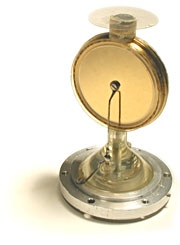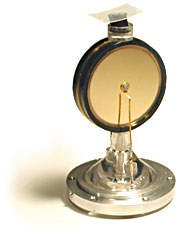
Gefell made M7 capsule from a 1957 Neumann UM57 microphone.

Gefell made M7 capsule from a 2002 Gefell UM92.1S microphone.

Paper rips unevenly accross the grain direction of the rolled fibers.

Paper rips straight across going with the grain of fibers... try it!
Gefell's
renowned M7 capsule
The art of microphone manufacturing begins in the capsule
and there is no capsule that has played a more important role
in the development of the microphone than the Gefell M7.
Originally designed by Georg Neumann in 1952, the M7 redefined the way we recorded music and completely shifted our listening expectations. All of a sudden, this new microphone could at once make the human voice sound larger than life, while bringing a clarity and detail to instruments that could never before be realized.
The Gefell M7 is a dual membrane capsule that is mounted on a triangulated pedestal. The M7 is the only capsule manufactured today that employs PVC (Poly-Vinyl-Chloride) as its substrate or base material. All other ‘plastic’ based capsules employ PE (Poly-Ethylene). This newer material is marketed under various brands such as Mylar and Hostaphan. These substrates are fashioned into a thin sheet and are coated with a gold surface that is eventually charged to create a capacitive effect. The term ‘metal film’ is derived from this process.
As a substrate, PVC is quite different from PE. PVC starts in a liquid form that is spread across a glass surface while PE is derived from a solid mass that is essentially rolled into a thin membrane. Because the manufacturing process involved in making PVC is both exceptionally difficult to execute and is subject to a much higher rejection ratio, it is impossible to buy PVC film. As a result, the PVC used to make the M7 is still made in the Gefell factory following the process that was outlined by Georg Neumann himself. Of course we now have access to more advanced technology, which allows us to attain significantly higher levels of purity. This has resulted in consistency and life expectancy to improve significantly.
The advantages of PVC are many although one may rightfully argue that these are character traits as opposed to benefits. Gefell offers microphones that are made with PE and PVC to address both perspectives.
Because PE is rolled in a particular direction, the molecular tension of the membrane becomes ‘firmly aligned’ depending on the direction it was rolled. PVC on the other hand is ‘fluid’ and as such, assumes its final molecular shape naturally. Because the membrane is more evenly tensioned, physical distortion is reduced. This ‘rubbery’ and more homogenous PVC diaphragm renders a more uniform transfer of the energy, which tends to sound more forgiving.
The M7’s PVC membrane is refined to a specific 10-micron thickness while the stiffer PE is generally trimmed to a diminutive 6 microns. The ‘heavier’ PVC further credits the M7 with its distinct character. This has side benefits of being less prone vocal ‘pops’ and less sensitive to problems caused by humidity deposits from the human voice on the membrane.
The
new Gefell M9 Capsule
Because PE (Mylar) is readily available, is easier to use,
and can be fashioned in to a lighter membrane, it has become
the material of choice for all metal-film microphone manufacturers.
The lighter PE material provides a more responsive capsule,
which results in greater sensitivity and articulation.
But manufacturing PE capsules is not without its challenges. As discussed above, due to the rolling procedure employed during manufacturing process, the molecular structure of PE becomes directional. This means that it has more resilience in the ‘roll’ direction. This prescribes that the capsule cannot be automatically tensioned to a given formula, but must be hand tensioned and ‘tuned’ like a drum skin for optimum performance. Hand tensioning by highly skilled employees is probably the single most important aspect that differentiates the hand-crafted Gefell M9 capsule versus all others.
Obviously from a manufacturing point of view, because PE can be purchased ‘off-the-shelf’ and it is also easier to work with, the M9 has the benefit of reduced parts and labour costs making it relatively affordable.
Gold
deposition
The heart of the ‘capacitive’ microphone is the
pressure gradient capsule. This is made up of two charged
plates that are brought closely together. When the active
membrane is set into vibration from the compression of air
molecules (we call this sound), a voltage differential is
generated that can then be amplified, recorded and eventually
played back through a transducer called a speaker.
In order to charge the capsule membranes, a thin conductive layer is deposited on the substrate. At Gefell, a thin 0.1 micron layer of 24-karat gold is evaporated on the membrane in a vacuum-locked chamber in order to get maximum uniformity. The more economical process of gold sputtering or ‘spray painting’ the capsule produces an uneven coat, which results in a membrane imbalance and the associated inconsistencies that one equates with inexpensive knock-offs. This makes correct tensioning impossible and of course is the trouble with low cost microphones.
Pure
metal capsules
The most challenging capsule to manufacture is the pure metal
diaphragm. These feature an ultra-thin membrane for maximum
sensitivity. Because of their exacting nature, less than a
handful of manufacturers produce pure metal diaphragms and
up until recently, these have been the exclusive tenure of
the test and measurement industry.
The most notable test and measurement microphone manufacturers in the world are B&K and Gefell. For instance, BMW (Bavarian Auto Works) uses Gefell test and measurement microphone arrays to monitor motor and part vibration during the manufacturing process of their automobiles. Both B&K (now marketed as DPA) and Gefell offer pure metal diaphragm microphones that have been voiced for use in music. DPA employs stainless steel for their membranes while Gefell employs pure nickel.
Nickel has several distinct advantages. Nickel maintains its performance better over longer periods and is less prone to react with atmospheric conditions such as humidity and pollutants. Furthermore, just as PE and PVC differ, steel and nickel follow the same characteristic discrepancies. Steel is rolled and therefore performs differently depending on the direction of the roll. Nickel is produced through a galvanizing process that once again is liquefied resulting in a more evenly distributed molecular structure.
Stainless steel is less expensive and easier to work with but is limited to how thin one can roll the material in order to increase sensitivity. As a result, steel membranes are usually no less than 1 micron thick while the nickel membranes in Gefell microphones are typically 0.8 micron for musical applications down to 0.4 micron for critical test and measurement.
Test and measurement microphones are most often seen as long slender microphones with small tips or probes. The reason for this is simple: Stretching these ultra-thin membranes is extremely difficult if one expects to yield a perfect transducer. The larger the diaphragm: the more difficult. Smaller diaphragms are exponentially less costly to produce and have the benefit of much less physical membrane distortion, which of course yields a ‘flat’ or more linear response. Unfortunately, this comes at the expense of being less sensitive which is why many engineers are not partial to the sound of these ‘clinical’ microphones.
The Gefell M294, M295 and M296 employ the Gefell N2 nickel diaphragm which is termed a 1” microphone even though it is only 22mm or about ¾” across. The 1” or large diaphragm categorization as used in the test and measurement world likely stems from the outer dimension of the probe or the size of the microphone’s outer capsule housing.
Large
versus small diaphragm
One of the most compelling arguments between audio engineers
is comparing the benefits and results that one can obtain
when using various diaphragm sizes. At Gefell, we believe
that it is our task to produce the very best microphone possible
and as such, a good microphone, no matter the size or construction
of the diaphragm, it should be perceived as a tool that can
be used just about anywhere on any source.
It
is however important to note that the size, thickness and
construction of the diaphragm will dictate how the microphone
will react when submitted to different sound sources. This
is why so many microphones exist and why each is voiced for
a specific application.
| Specification | Large diaphragm | Small diaphragms |
| Sensitivity Physical distortion Musically appealing Linear response Precision recording Directivity Level handling (metal) Level handling (plastic) Challenge to build |
More More More Less Less Less Less More More |
Less Less Less More More More More Less Less |
| Type of capsule | Advantages | |
| Small diaphragm (16mm or about ½”) | Better
directivity More even response curves Better for live performances Less feedback on stage Less sensitive to solid borne noise Less handling noise Less proximity effect More accurate and critical Better for instruments |
|
| Large diaphragm (25.4mm or 1”) | More
musical Better low frequency response More sensitive Lower self noise Greater proximity effect Warms up the source Smooth and complimentary Better for voice |
|
One of the most important aspects involved in manufacturing a microphone is the method in which the sound emanating from the source is managed. The mechanical design attributes such as the protective head grill, the size of the microphone and the way that the capsule is mounted all play critical roles in ‘acoustical’ performance of the microphone.
The Gefell M7, as with all other Gefell capsules, is designed to minimize the reflections that come off the microphone body and capsule housing so that the intended source is not contaminated by phase cancellation. This is achieved by reducing the microphone body size to a minimum and by mounting the larger capsules on a triangulated pedestal.
Smaller mics such as the M300 makes use of an innovative dampened spring that both secures the capsule in place while virtually eliminating any internal reflections. This careful attention to detail not only assures excellent on-axis response, but produces a more even off-axis response as one moves away from the front of the capsule to the sides.
The capsule amplifier
Condenser microphones are made up of the capsule and the electronics.
The electronics serve several functions: To begin, this is
where the power is distributed such as from the 48V phantom
power source. Furthermore, these electronics serve as a capsule
pre-amplifier to augment the minute signal from the capsule
to a workable level while the exceedingly high capsule impedance
is dropped to match the low-impedance balanced inputs found
on the mixing console or mic preamp.
At this level, capsule amplifiers are usually either tube or FET powered. Tube microphones are renowned for their apparent warmth, which may be attributed to the slower reactive rise time of the tube and the natural even harmonic distortion that is pleasing to the human ear. The Gefell M92.1S and the M990 both use an EF86 pentode tube.
FET or field effect transistor capsule amplifiers benefit the microphone with faster transient response, greater dynamic range and a wider frequency response. The lower power required to drive FET mics allow them to be used with phantom power while tube mics require a dedicated voltage supply. (The Gefell UM900 Phantom Tube being the only exception)
All Gefell tube microphones employ a transformer-coupled output that allows the microphone to be stationed at longer distances from the power supply. Transformers inherently reduce common mode noise or 60-cycle hum, which of course can be most problematic with tubes.
The latest FET technology developed by Gefell incorporates optical isolation of the DC supply to reduce ripple and hash from entering the microphone. Optical isolation may be equated to a solar panel whereby a light impulse is bridged across a gap and reconverted into an electrical impulse thus decoupling the source and the destination with an optical bridge. This effectively performs the task of a transformer without the ringing or bandwidth limitation that is usually associated. By providing pure DC to the capsule, one enjoys both improved performance and lower self-noise, most notably in the broadband spectrum.
A
transformerless symmetrical output stage is employed which
has the benefit of balancing the signal while providing full
bandwidth at the output. This also allows the electronics
to be reduced to the smallest denominator, which of course
advantages the microphone by causing less acoustic field disruption.